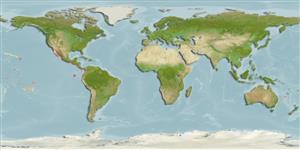Environment: milieu / climate zone / depth range / distribution range
Écologie
marin récifal; profondeur 3 - 68 m (Ref. 5227). Tropical
Eastern Pacific: Baja California to Peru, including the Galapagos and other offshore islands.
Taille / Poids / Âge
Maturity: Lm ? range ? - ? cm
Max length : 28.0 cm TL mâle / non sexé; (Ref. 5227)
Épines dorsales (Total): 3; Rayons mous dorsaux (Total): 23-26; Rayons mous anaux: 16 - 18; Vertèbres: 24. Sides of body, excluding cheeks, mottled with cream to pale-brown blotches on dark background, reaching onto bases of median fins; blotches are poorly-defined and often coalescing. Body and head, excluding lips and maxillary, with embedded scales. Dorsal spines 3 (rarely 2). Lower jaw projecting, with prominent fleshy protuberance. Numerous, small pores, in patches, along ventral surface of lower jaw and on the free-edge of preopercle in > 6.5 cm SL specimens (Ref. 40934).
Lives in rocky reefs, sheltering in caves and crevices but also encountered in the open (Ref. 11482). Lies motionless, often on its side, hidden in dark recesses. Actively hunts at night, preying on small fish (Ref. 5227).
Life cycle and mating behavior
Maturité | Reproduction | Frai | Œufs | Fécondité | Larves
Allen, G.R. and D.R. Robertson, 1994. Fishes of the tropical eastern Pacific. University of Hawaii Press, Honolulu. 332 p. (Ref. 11482)
Statut dans la liste rouge de l'IUCN (Ref. 130435)
Menace pour l'homme
Harmless
Utilisations par l'homme
Plus d'informations
Noms communsSynonymesMétabolismePrédateursÉcotoxicologieReproductionMaturitéFraiRassemblement de ponteFéconditéŒufsDéveloppement de l'œuf
RéférencesAquacultureProfil d'aquacultureSouchesGénétiqueElectrophoresesHéritabilitéPathologiesTraitementNutrientsMass conversion
CollaborateursImagesStamps, Coins Misc.SonsCiguateraVitesseType de nageSurface branchialeOtolithesCerveauxVision
Outils
Articles particuliers
Télécharger en XML
Sources Internet
Estimates based on models
Preferred temperature (Ref.
123201): 20.6 - 28.9, mean 25.9 °C (based on 82 cells).
Phylogenetic diversity index (Ref.
82804): PD
50 = 0.5010 [Uniqueness, from 0.5 = low to 2.0 = high].
Bayesian length-weight: a=0.01738 (0.00680 - 0.04443), b=3.01 (2.78 - 3.24), in cm total length, based on LWR estimates for this (Sub)family-body shape (Ref.
93245).
Niveau trophique (Ref.
69278): 4.0 ±0.7 se; based on size and trophs of closest relatives
Fishing Vulnerability (Ref.
59153): Low vulnerability (18 of 100).
Nutrients (Ref.
124155): Calcium = 44.6 [25.1, 94.7] mg/100g; Iron = 0.517 [0.281, 0.958] mg/100g; Protein = 18.2 [16.3, 19.9] %; Omega3 = 0.131 [0.078, 0.212] g/100g; Selenium = 32.1 [18.1, 62.3] μg/100g; VitaminA = 78.8 [20.8, 340.7] μg/100g; Zinc = 0.966 [0.632, 1.471] mg/100g (wet weight);
